Semi‑precious stone slabs—crafted from agate, quartz, jasper, and other gem‑quality minerals—bring a sense of luxury and natural artistry to countertops, walls, and furniture. Unlike conventional stone slabs, these are assembled from thin, polished gemstone slices bonded together with high‑performance resins. The result is a translucent, durable surface that can be backlit for dramatic effect, showcasing the stone’s intrinsic hues and patterns.
The Art and Science of Gemstone Slabs You Should Know
Table of Contents
ToggleSemi‑precious slabs originate from lapidary arts, where rough stones are first cut, shaped, and polished into thin veneers. The term “lapidary” comes from Latin lapis (“stone”) and refers to techniques—tumbling, cabochon cutting, faceting—used to reveal a gem’s beauty. Modern fabricators harness both age‑old craftsmanship and CNC‑driven precision to produce slices as thin as 3–5 mm, suitable for seamless assembly under epoxy or polyester resins. This fusion of natural geology and polymer science enables light transmission through translucent stones like agate, creating luminous installations in luxury interiors.
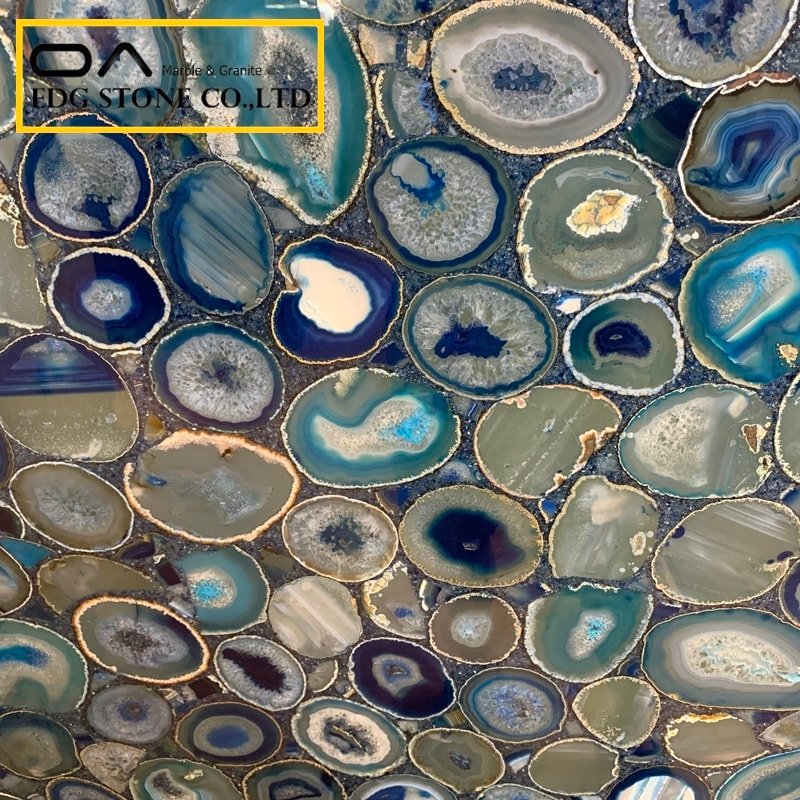
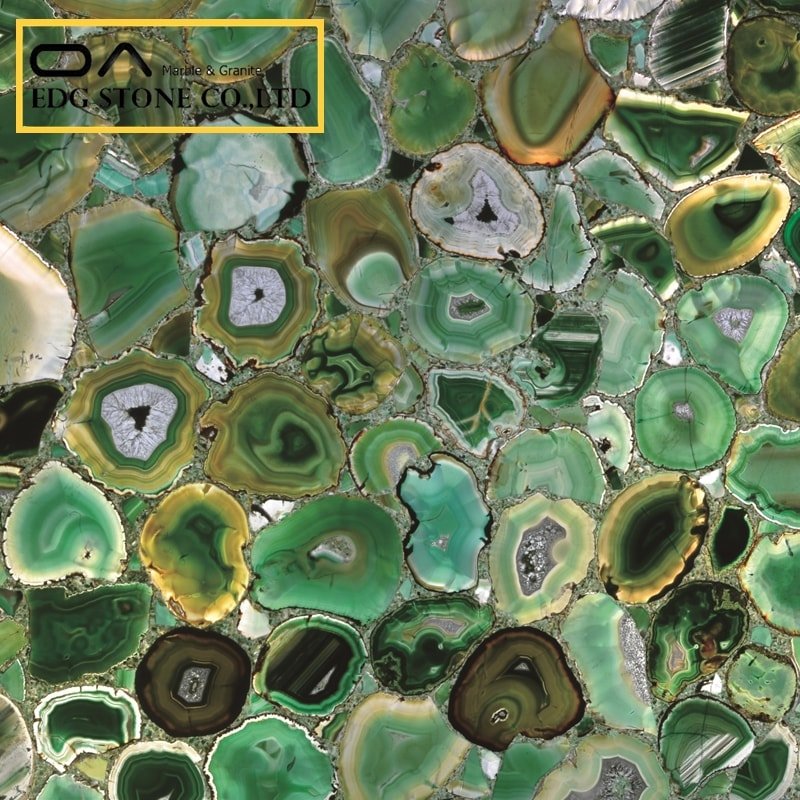
How are Gemstone Slabs Made?
Quarrying & Rough Cutting: Large blocks of semi‑precious stone (e.g., agate, amethyst, malachite) are extracted using diamond‑wire saws or water‑jet cutters, ensuring minimal micro‑fractures.
Primary Slicing: Blocks are sawn into slabs 10–20 mm thick; these are then trimmed to remove irregular edges.
Fine Grinding & Polishing: Slabs pass through progressively finer diamond abrasives (from 220 up to 50,000 grit) to achieve a mirror finish that highlights veining and translucency.
Resin Bonding: Individual veneer slices are laid out in artistic patterns on a substrate and infused with clear epoxy or polyester resin, filling gaps and creating a monolithic surface. High‑performance resins provide UV stability, scratch resistance, and moisture sealing.
Curing & Finishing: The bonded slab cures under controlled heat or UV light. Final edge profiling and surface leveling guarantee a flawless, ready‑to‑install product.
Understanding Semi‑Precious Stone Slab Prices
Pricing hinges on several factors:
Stone Type & Rarity: Agate and amethyst command $250–$500 per sq ft due to color richness; common quartz composites start around $100 per sq ft.
Quality & Grade: Higher clarity and uniformity of slices increase costs; branded “premium” or “factory‑direct” slabs can add a 15–30% markup.
Slab Size & Thickness: Large-format slabs (up to 3 m × 2 m) and 3–5 cm thickness fetch higher prices due to material yield and handling complexity.
Finishing & Customization: Backlit‑ready slabs with integrated resin channels or special edge profiles (waterfall, bullnose) incur extra fabrication fees.
Unique Semi-Precious Stone for Popular Home Decor
Semi‑precious slabs elevate interiors by serving as:
Backlit Feature Walls: Translucent agate slabs with LED backing transform bars, headboards, or reception desks.
Luxury Countertops & Vanities: Amethyst or labradorite slabs add iridescent sparkle to bathrooms and kitchens, paired with white or dark cabinetry to accentuate color shifts.
Tabletops & Furniture Inlays: Smaller diced slabs can be inlaid into tables, bar fronts, and coffee tables for one‑of‑a‑kind statement pieces.
Architectural Accents: Columns, fireplace surrounds, and bar backs showcase natural patterns in high‑traffic commercial and residential spaces.
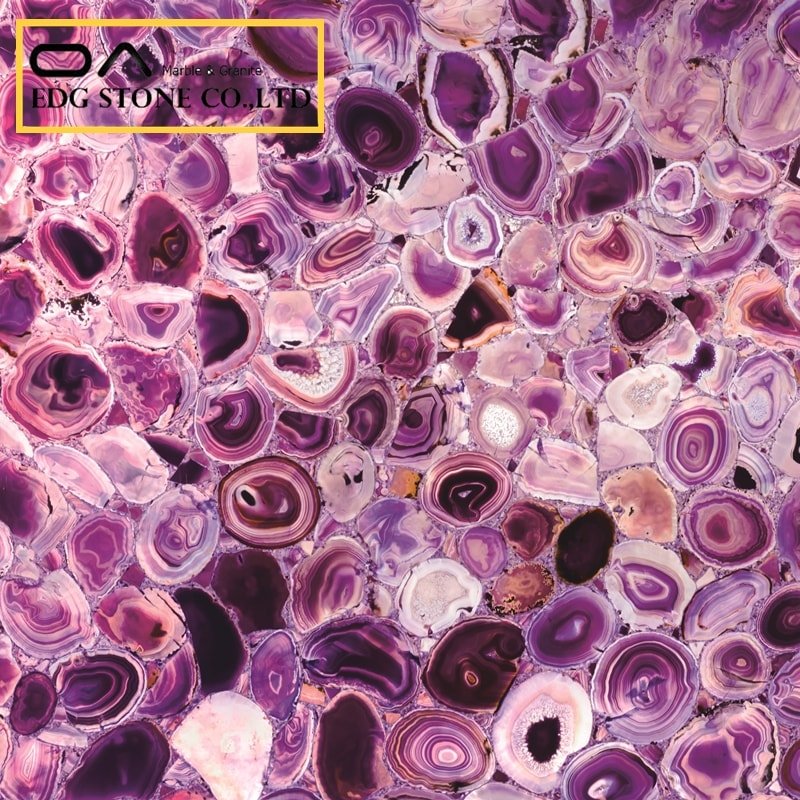
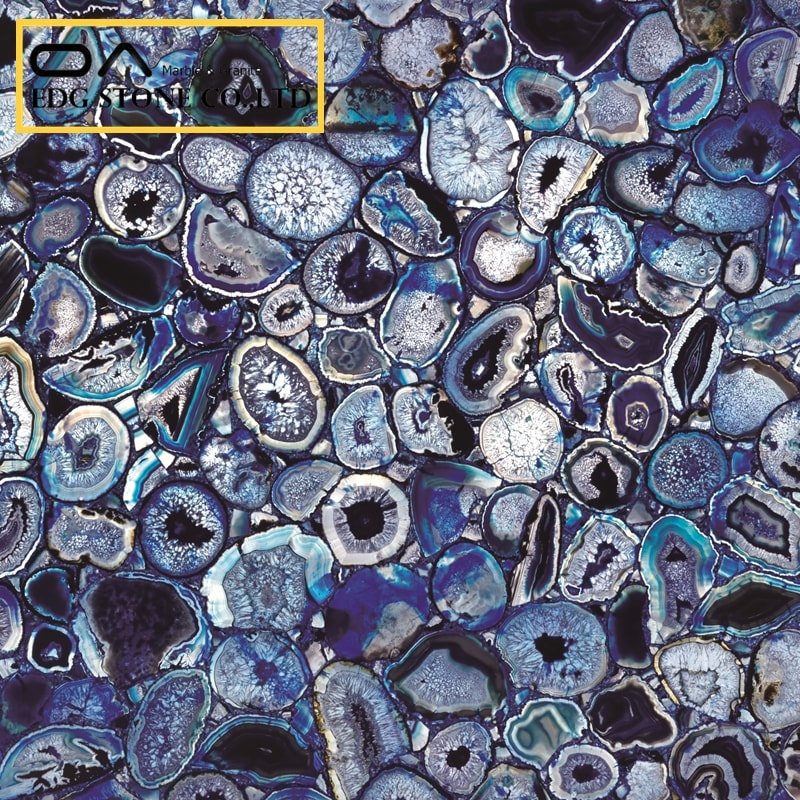
Complete Guide to Semiprecious Stones: Beauty, Care, Use
Mohs Hardness: Most semi‑precious stones range 6–7, making them suitable for surfaces but requiring sealing to prevent etching by acids en.wikipedia.org.
Maintenance: Wipe with mild soap and water; avoid harsh acids. Reseal annually or as per manufacturer recommendations to maintain shine and stain resistance.
Longevity: With proper care, semi‑precious stone slabs retain color and polish for decades, offering a lifetime of visual appeal.
Applications Recap: Countertops, backsplashes, furniture inlays, wall cladding, art installations.
Semiprecious Stone Slabs for Countertops, Residential
Material Selection: Choose agate for bold color, quartz for durability, and jasper for earthy tones.
Design Coordination: Match slab veining with cabinet and wall paint colors (e.g., warm beige or deep charcoal) for cohesive aesthetics.
Installation Considerations: Backlit installations require wiring recesses and specialized mounts; standard countertops need a level substrate and mechanical anchoring.
Budgeting & Sourcing: Compare natural stone slab suppliers and wholesale offers, factor in shipping from China or Brazil, and request sample slices before bulk purchase.
Unique Semi-Precious Stone for Popular Home Decor
(Revisited for additional ideas)
Artisanal Jewelry Counters: Slabs can be repurposed into fluid jewelry displays or countertop insets, bridging home décor with wellness spaces.
Branded Retail Installations: High‑end boutiques use backlit onyx or agate slabs in window displays to convey exclusivity.
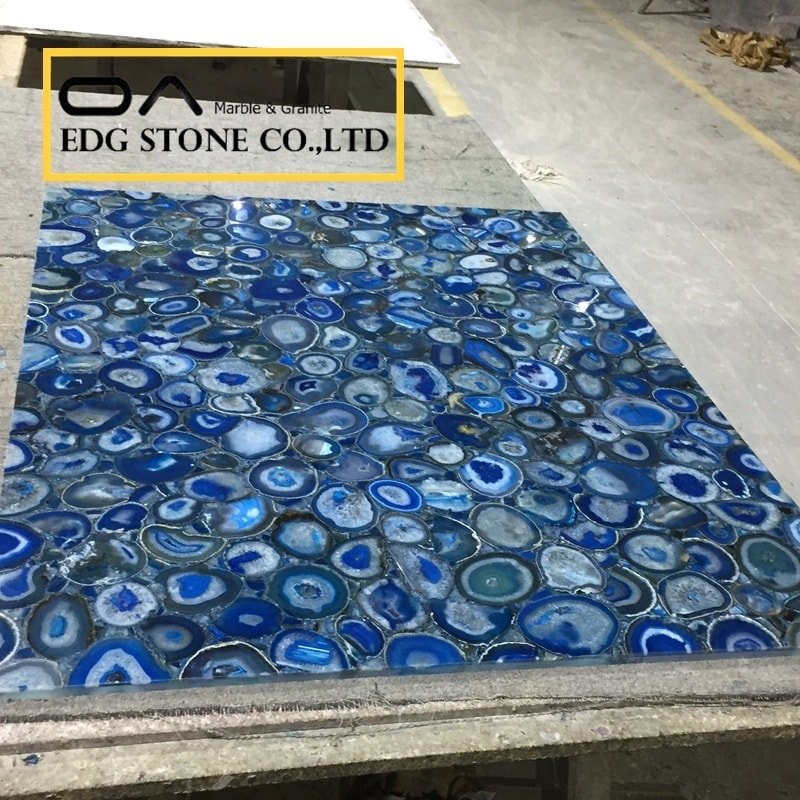
FAQs
How are semi‑precious stones made?
Semi‑precious stones form naturally via geological processes—mineral solutions crystallize in cavities, fractures, or between sedimentary layers. Lapidary techniques then extract, slice, and polish these crystals into veneers for slab fabrication.
How to make stone slabs?
Raw blocks are sawed into slabs, ground flat, and then polished. For semi‑precious slabs, individual slices are arranged and bonded with resin, cured, and re‑polished to ensure a seamless surface.
Are semi‑precious stones expensive?
Yes—their rarity and manual processing elevate prices. Agate and amethyst slabs often range $250–$500 per sq ft, while composite quartz slabs start near $100 per sq ft.
What does it mean if a stone is semi‑precious?
Semi‑precious stones are gem‑quality minerals not classified among the traditional “big four” (diamond, ruby, sapphire, emerald). They include quartz, agate, jasper, amethyst, and others valued for color and pattern.
What are the 4 semi‑precious stones?
Commonly referenced are amethyst, citrine, garnet, and peridot, though definitions vary by market and historical context.
Which color stone is most expensive?
Among semi‑precious varieties, deep purple amethyst and intense green malachite command premium rates due to desirability and processing complexity.
Which gemstones hold their value?
Agate, amethyst, and jasper slabs maintain value when well‑made; however, market prices fluctuate with trends and scarcity.
What is the #1 rarest gem?
Paraíba tourmaline and tanzanite are among the rarest; however, these are rarely used for slab fabrication due to cost.
What is the best semi‑precious stone?
Subjective—agate is prized for vivid banding; amethyst for color; labradorite for schiller effect. Choice depends on design goals.
What is the rarest semi‑precious gemstone?
Green garnets like tsavorite and red spessartite garnets rank among the rarest.
What’s the best stone for money?
Quartz variants (rose, smoky) offer affordability and durability, making them cost‑effective for large slabs.
What kind of rock is worth money?
Gemstone‑quality agate, jasper, and amethyst command significant sums when fashioned into slabs.
How to tell if a stone is valuable?
Assess color saturation, clarity, unique patterns, and provenance; certified grading adds credibility.
What is the most beautiful crystal in the world?
Beauty is subjective; clear quartz, rose quartz, and amethyst are frequently celebrated.
What are semi‑precious stones called?
Also known as gemstone aggregates or lapidary stones, when cut for slabs.
What stones are worth more than diamonds?
Certain rare tourmalines, alexandrite, and fine jade can exceed diamond per‑carat prices but are seldom used in slabs.
Conclusion
From the quarry to the showroom, crafting semi-precious slabs fuses ancient lapidary techniques with cutting‑edge resin technology. Whether used as backlit feature walls, luxurious countertops, or bespoke furniture inlays, these slabs transform spaces with their unique color, translucency, and pattern. By understanding sourcing, pricing, and fabrication processes, designers and homeowners alike can select the perfect gemstone slab to complement any décor, ensuring each installation is as durable as it is breathtaking.
30 SEO-Friendly Tags:
Semi Precious slabs,Gemstone slabs,Semi precious stones,Natural stone slab suppliers,Precious stone countertops,how to make semi precious stone bracelets,semi precious stone slabs for sale,semi precious stone slabs,semi precious slabs,super easy tutorial to create the latest semi-precious stone,semi precious stones for jewelry making,gemstone slab manufacturing,artisanal stone fabrication,resin bonded gemstone slabs,backlit agate slabs,wholesale gemstone slabs,semi precious slab supplier,semi precious stone factory,semi precious manufacturers,buy gemstone slabs,cheap semi precious slabs,China stone slabs,high quality gemstone slabs,luxury stone countertops,decorative stone panels,lapidary stone slices,custom stone slabs,semi precious slab prices,epoxy bonded stone,translucent stone surfaces,